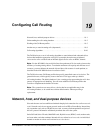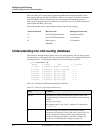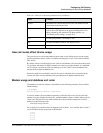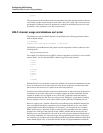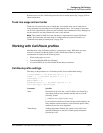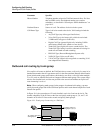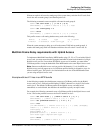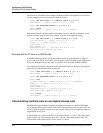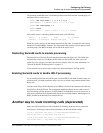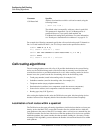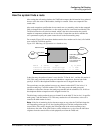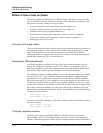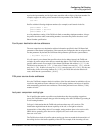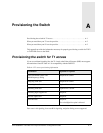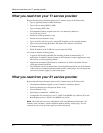
Configuring Call Routing
Another way to route incoming calls (deprecated)
APX 8000/MAX TNT/DSLTNT Physical Interface Configuration Guide Preliminary May 9, 2000 19-9
The following commands create a Call-Route profile to route calls received on trunk group 4 to
the Hybrid Access card in slot 4:
admin> new call-route { { { 1 4 0 } 0} 0}
CALL-ROUTE/{ { { shelf-1 slot-4 0 } 0 } 0 } read
admin> set trunk-group = 4
admin> write
CALL-ROUTE/{ { { shelf-1 slot-4 0 } 0 } 0 } written
This profile creates a call-routing database entry such as the following:
device # source type tg sa phone
1:04:01/1 0 0:00:00/0 digital-call-type 4 0
When the system receives an add-channel request from the caller, it searches the call-routing
database for available HDLC channels. This entry ensure that when the add-on request is made
on trunk group 4, the HDLC channels will reside on the card in slot 4.
Dedicating Series56 cards to modem processing
The Series56 II and Series56 III cards handle both modem and digital calls. The TAOS unit
automatically creates two Call-Route profiles when you first install one of the cards: one
profile for voice call type (a modem call) and one for digital calls. For more information, see
“Series56 II and III Call-Route profiles” on page 5-4.
If you want the card to answer only modem calls, delete the Digital-Call-Type profile.
Enabling Series56 cards to handle HDLC processing
If you want Series56 II and Series56 III cards to answer HDLC calls, then no matter where you
install the card, you might experience delays as it tries to answer single channel nailed Frame
Relay calls.
To reduce such delays, install a Hybrid Access (HDLC) card in a lower-numbered slot than any
Series56 II or Series56 III card. This arrangement enables the Hybrid Access card to answer
the Frame Relay call first. However, if all the channels in the Hybrid Access card are in use, or
have been used before, the TAOS unit looks for the next available channel, which might be an
HDLC channel in the Series56 II or Series56 III card.
Another way to route incoming calls (deprecated)
Many network line profiles provide a parameter for directing incoming calls to a particular
host interface. Following are the relevant parameters, shown with default settings:
[in T1/{ any-shelf any-slot 0 }:line-interface:channel[1]]
call-route-info = { any-shelf any-slot 0 }
[in E1/{ any-shelf any-slot 0 }:line-interface:channel[1]]
call-route-info = { any-shelf any-slot 0 }



